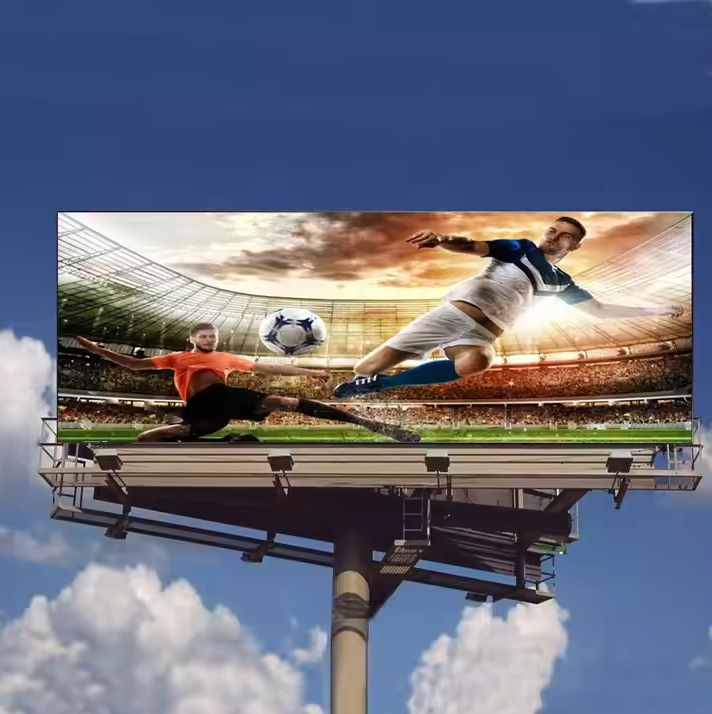
How to choose the ultimate guide for waterproof outdoor LED screens?
Introduction:

1. Understanding Waterproof Ratings: Demystifying IP Codes
Ingress Protection (IP) is a key factor when selecting an outdoor LED screen.The IP code indicates the level of protection against solid particles (such as dust) and liquids (such as water).
-
The first digit (protection against solid particles): The range is from 0 (no protection) to 6 (full dust protection). For outdoor use, select the IP6X rating to ensure that dust cannot enter the display.
-
The second digit (liquid ingress protection): The range is from 0 (no protection) to 9 (protection against high-pressure water jets). For outdoor screens, IPX5 (protection against water jets) or higher is recommended. In heavy rainfall areas, consider IPX7 (temporary immersion) for added safety.

2. Key Factors to Consider When Choosing Waterproof Outdoor LED Screens
2.1 Environmental factors
Outdoor conditions vary greatly, so it is important to choose a screen that can withstand a particular climate:
-
Rain and humidity: Choose a screen that is highly water resistant (IP65 or higher).
-
Extreme temperatures: Look for screens with a wide operating temperature range (-20°C to 50°C or higher).
-
Wind and salt spray: In coastal areas, choose corrosion-resistant materials and sturdy mounting structures.

2.2 Screen specifications
-
Brightness (nits): Outdoor screens require high brightness to withstand sunlight. A target brightness of 5000 nits or higher is required for clear visibility.
-
Pixel pitch: Image clarity is determined by viewing distance. For example, a pixel pitch of 10 mm is suitable for viewing distances of 10-20 meters.
-
Resolution: The higher the resolution (e.g. 1920×1080), the clearer the image, especially for close viewing.
-
Viewing angle: Choose a screen with a large viewing angle (140° or greater) to ensure that you can see from multiple directions.

2.3 Durability and build quality
-
Materials: Aluminum alloy cabinets are lightweight, durable, and corrosion resistant.
-
Protective features: UV-resistant coatings and impact-resistant glass extend service life.
-
Sealing: Ensure that all seams and connections are tightly sealed to prevent water ingress.
2.4 Maintenance and serviceability
-
Front/Rear service access: Easy maintenance without dismantling the entire screen.
-
Modular design: Faulty modules can be quickly replaced.
-
Hot-swappable components: Minimizes downtime during maintenance.
3. Applications of Waterproof Outdoor LED Screens: Where to Use Them
Waterproof outdoor LED screens are versatile and can be used in a variety of settings to maximize visibility and engagement. Here are some of the most common applications:
3.1 Urban advertising
-
Billboards: High-brightness LED screens are perfect for busy city centers, highways, and transportation hubs.
-
Shopping malls: Display dynamic advertisements and promotions on outdoor LED screens to attract foot traffic.
-
Public Spaces: Use screens in parks or plazas for community announcements or event promotions.

3.2 Sports and entertainment venues
-
Stadiums: Enhance the fan experience with live replays, scores, and ads on large LED displays.
-
Concert halls: Create immersive visuals for outdoor concerts and events.
-
Race tracks: Display live game updates and sponsor advertisements.

3.3 Transportation hubs
-
Airports: Provide flight information, advertisements, and wayfinding assistance on LED screens.
-
Bus and train stations: Share schedules, safety information, and local business advertisements.
-
Parking lots: Guide drivers with real-time availability and pricing information.

3.4 Retail and hospitality
-
Storefronts: Engage customers with lively product displays and promotions.
-
Restaurants and cafes: Showcase menus, daily specials, and events.
-
Hotels and resorts: Display event schedules, weather updates, and local attractions.

3.5 Corporate campuses and institutions
-
Corporate Buildings: Share company news, announcements, and motivational messages.
-
Universities: Provide event schedules, emergency alerts, and campus maps.
-
Hospitals: Display wayfinding information, health tips, and appointment reminders.

4. Installation and Maintenance Tips for Waterproof Outdoor LED Screens
Installation tips
-
Professional installation: Always hire experienced technicians to ensure proper mounting and wiring.
-
Mounting structure: Use sturdy, weather-resistant materials such as galvanized steel.
-
Ventilation: Ensure adequate air circulation to prevent overheating.
Maintenance tips
-
Routine cleaning: Clean the screen surface with a soft cloth and a neutral detergent.
-
Inspect connections: Periodically check cables and connectors for wear and tear.
-
Monitor performance: Look for dead pixels, color inconsistencies, or brightness problems.

Conclusion
Choosing the right waterproof outdoor LED advertising screen is essential for maximizing your investment and ensuring long-term performance. By understanding IP ratings, evaluating environmental factors, and selecting a high-quality screen, you can create impactful outdoor advertising that stands up to the elements.
